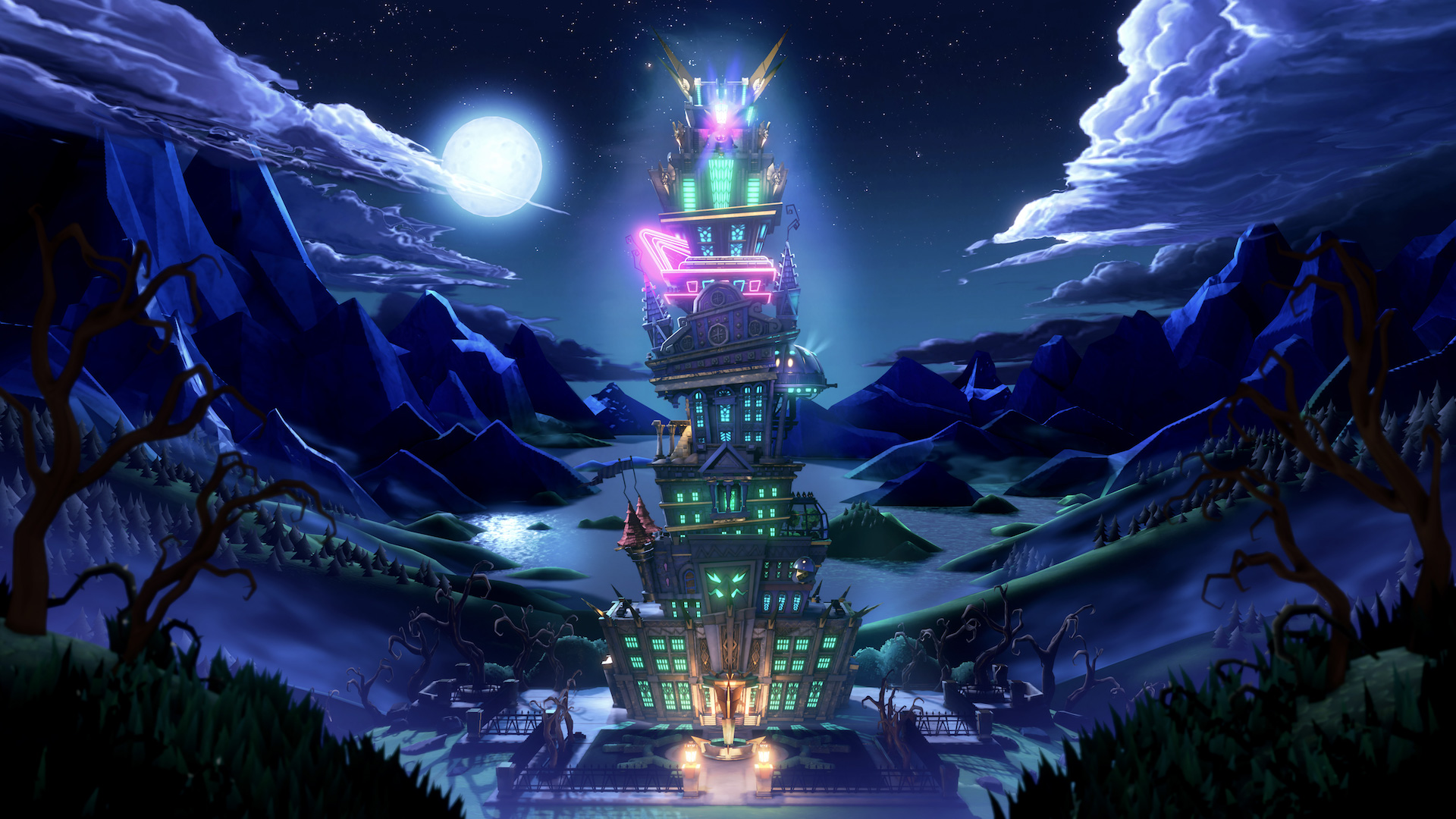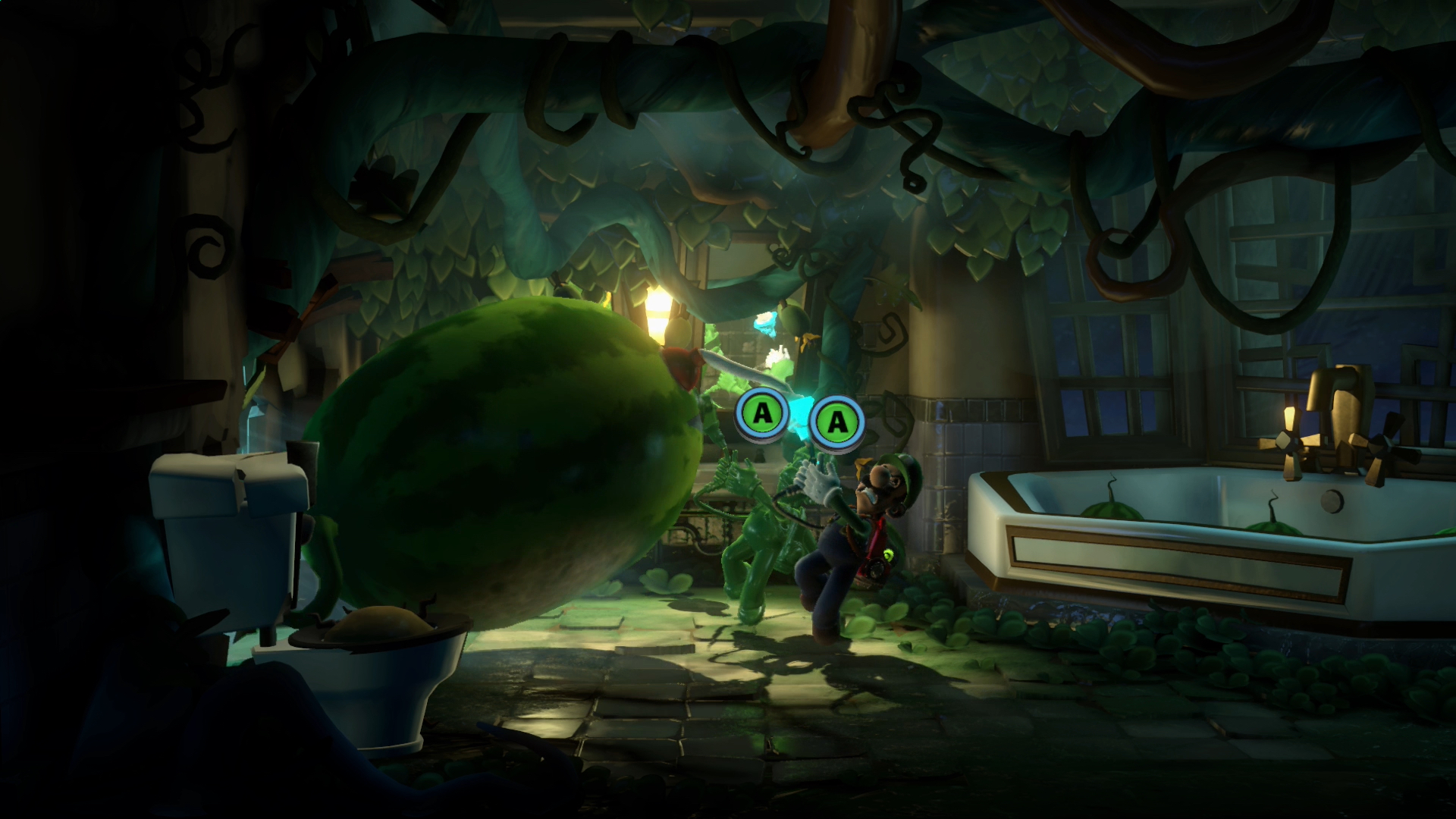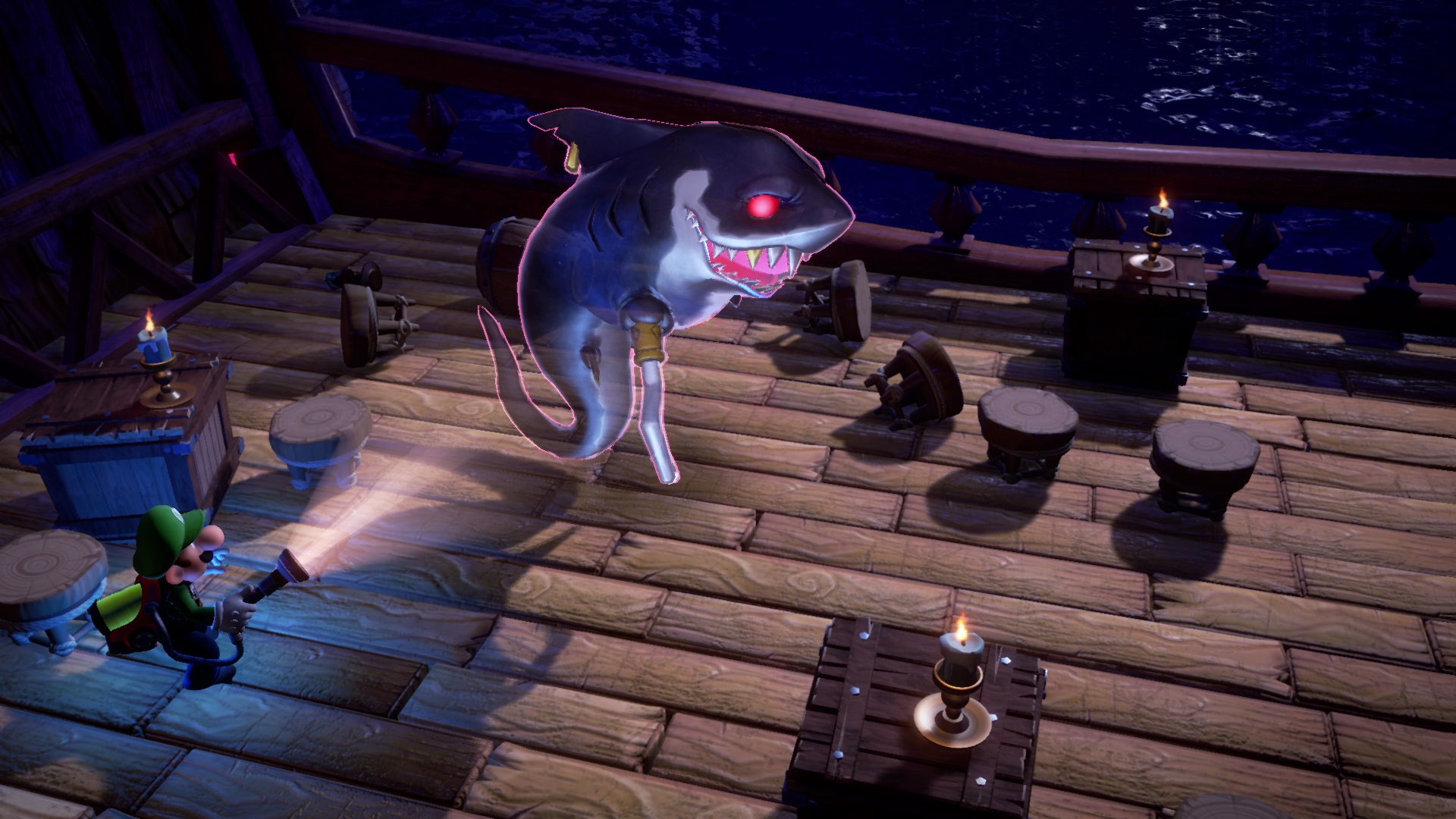Luigi’s Mansion 3 doesn’t take place in a mansion. It takes place in a hotel that doubles as a natural history museum, a movie studio, a pirate’s cove theme bar, and an ancient Egyptian burial site, implying beneath the ground despite the fact that it’s located on the 10th or 11th floor. These impossible dimensions bring to mind another one of 2019’s haunted structures, Control’s Oldest House, with floors that are actually multiple stories tall. I guess, in some ways, the hotel in Luigi’s Mansion 3 has rooms you might find in a cartoon mansion, though arranged vertically instead of horizontally, as if they were taken apart and reassembled by stacking them on top of one another.
The change of setting brings up the question of why call it Luigi’s Mansion 3 and not something closer to Luigi’s Hotel or Weekend at Luigi’s. Nintendo’s always had some semblance of a naming convention when it comes to sequels, but even the Super Mario series strayed from the numbered naming convention once it hit the third dimension. Still, the phrase “Luigi’s Mansion” is now synonymous with the green-hatted wonder hunting ghosts with a vacuum while solving puzzles, so why call it anything different? It works. It’s just so weirdly, baldly wrong.
But Luigi’s never been the most conventional character. Starting as a palette swap of his brother, Luigi has become a meme as the beleaguered sidekick of Nintendo’s favorite son, with a more nasally voice (the mark of a true nerd) and a goofier, more desperate jump, always kicking his legs as if he’s unsure about if or when he’s going to land. Luigi embodies the lovable loser, the second fiddle, so deeply that there’s a dedicated button in Luigi’s Mansion 3 for him to meekly call out for his brother, even though he knows Mario is trapped in a painting.

Nintendo and its stable of friendly studios (in this case, Next Level Games) have a knack for connecting disparate themes and pretending as if they were always naturally a match. That leaves can give Mario a raccoon tail that somehow lets him fly is a fact of this world that makes no apparent sense but is unquestionably just and true. The same can be said about ghosts and paintings and how inextricably those two concepts are tied in the Luigi’s Mansion series. This time, however, instead of needing to put King Boo back into a painting, Luigi has to rescue Mario, Peach, and three toads from a painting inside which King Boo has trapped them after luring the group with the promise of a free weekend getaway and a luxury hotel. This time, King Boo teams up with a more sultry ghost, Helen Gravely, and her roster of ghouls to take down the heroes of the Mushroom Kingdom once and for all. Why? Who knows!
Miraculously, Luigi escapes being trapped in the painting and ends up finding Professor E. Gadd, who once again supplies him with an updated version of the Poltergust, the G-00. Not only does it come with all the same functionality it had in Dark Moon, but it’s also got a few new tricks up its sleeve, including a plunger that functions as a grappling hook and a mind-controlled doppelganger known as Gooigi.
What Gooigi is, and the strangeness of its existence, entirely depends on whether you’re playing Luigi’s Mansion 3 alone or with a friend. Meant as a way to introduce co-op to the series, Gooigi as player two becomes a silent companion, a marvel of modern science, able to slip through grates and get to those hard-to-reach places. Coordinating with another player as Gooigi becomes a bonding experience. However, as a solo player, controlling Gooigi can be an existential nightmare. That’s not to say that the all-green double doesn’t add an interesting complication to single-player puzzles, but the questions about the nature of Gooigi’s existence are more unsettling than the ghosts Luigi is busting. While you’re controlling one, the other slumps into unconsciousness—the psychic connection momentarily activated, the electronic currents of the mind serving a different master.

Like the original upon which it is based, Gooigi’s meme potential is off the charts. Gooigi is as lazy as character design gets; it’s a see-through green facsimile of a punchline that doesn’t even have its own distinct personality as, say, a rascally, mischievous counterpart. But that’s, in part, what makes the introduction of Gooigi so charming: What other character deserves so unoriginal a spin-off character as Luigi himself? Surely, we’ll be seeing Gooigi again, in future iterations of Mario Kart or Mario Tennis. Maybe even the next Smash Bros. will figure out a way to make Luigi an interesting fighter by giving him an Ice Climbers-style Gooigi companion. Gooigi is an enigma, an ambiguity, a blank replicant toward which even Luigi can punch down.
Where Gooigi feels like an added complication and an excuse for multiplayer, the Poltergust G-00’s new functions actually feel like straight upgrades. Most obvious is the new Slam move, which lets you suck up a ghost and then whip it around. Doing so damages the ghost and more quickly drains its HP, while also giving you a temporary flail against other ghosts in the vicinity. It makes “combat” (if you could call it that) quicker and more action-packed, instead of just being a game of tug-of-war and chicken the way it was in the previous entries. Prioritizing your targets becomes a little less important, but it also allows the fights against ghosts to become more hectic without being as annoying.
That’s not the only new move the Poltergust has. The Suction Shot and the Burst are arguably even more important to how Luigi’s Mansion 3’s enemy encounters and boss fights play out. These new moves have to counter something, allowing Next Level’s designers to expand upon the ghosts’ different movesets. Certain ghosts might be wearing protective eyewear that you’ll have to suck up with your vacuum in order to stun them with the Poltergust’s flashbulb. But, in order to do that, you’ll first have to hit them in the face with a plunger. Other ghosts might be hiding under giant tophats or charging at you with their heads down, or else try to get you with a sweep attack, requiring you to use the Burst to launch yourself and nearby items into the air. These new abilities make combat a dynamic event as opposed to a necessary distraction; I actually looked forward to being penned in by ghosts and seeing what new twist or combination of enemy types the game was going to throw at me.

Boss fights, too, are more dynamic than in previous games, thanks to the G-00’s upgrades—but that can also make them a little more frustrating. The solutions to each boss are generally pretty obvious, but I still found myself sometimes struggling to read the cues. After a while, you get the hang of when you should be attacking and which moments require a more defensive approach. Most often, the answer is to wait, which makes boss fights feel more passive than standard enemy encounters. It can also make you wonder whether you’re simply not executing on your idea properly or if you’re just wrong to begin with. The default control setup can make precision attacks seem needlessly challenging to execute, but thankfully Next Level Gaming gives players a few helpful options for how they want to play. Specifically, I’d recommend everyone who has experience playing third-person shooters to change the setting for “Movement while Poltergusting” from “Turn” to “Don’t Turn,” as this will make strafing while using the Poltergust much easier and more natural. Similarly, I completely turned off the gyro controls, as I found them more of a hindrance than a help. The only option that Next Level didn’t include—one that they really should add with a patch—is the option to turn off the obnoxious beeping sound that occurs when Luigi is low on health. More than once I killed myself and used a reviving bone just so I wouldn’t have to listen to the obnoxious beeping sound.
Tower of Terror
Luigi’s Mansion 3 makes two separate attempts at shoehorning in multiplayer, one that’s online and one that’s off. ScareScraper (it’s like a skyscraper but scary) is online, and it tasks up to four players with completing somewhat random tasks like clearing ghosts or collecting money on either five or ten floors of the hotel. Unlike in the single-player story, however, each floor is just a generic hallway with boring rooms, and not the intricate theme parks that you’ll be used to from the campaign. You can supposedly chat with your random teammates through a lobby chat on the Nintendo app on your phone, but there’s nothing in the game that prompts you to do so, and I’ll be damned if I’ll ever accept that as a genuine solution to voice chat.
The other, offline side of the game’s multiplayer is ScreamPark. Up to eight players can play several competitive minigames on one Switch console, but you’ll obviously need the right amount of Joy-Cons and/or Pro controllers to maximize the zaniness. These minigames are much more in line with the kind of Mario Party-style shenanigans you’d expect from a Nintendo-published game; it’s just a shame that they’re strictly relegated to offline play. Like with the dungeon builder in the recent Link’s Awakening remake or the multiplayer in Mario Maker 2, these modes seem like fun experiments, but they’re hampered by Nintendo’s hesitation in fully committing to multiplayer services and new ideas.
Aside from some minor annoyances, Luigi’s Mansion 3 is the perfect sequel for a strange series. Even if it isn’t a mansion, the Last Resort hotel makes for a rich playground full of physical objects to toss about and suck up. There’s just more texture in general, not only in the graphics but in the world as a whole. In other words, and to Next Level’s credit, it doesn’t feel like a phoned-in spin-off. It’s rich with content and mechanically layered, with its own lore, its own sense of style. But, of course, that never seems to register with Luigi. No matter how many ghosts he’s defeated, he’s still afraid of his own shadow. He still meekly calls out for his brother. He still shakes like a leaf. I think we all know that, deep down, Luigi will never be Mario. Even Luigi himself knows that—but that’s what makes him special.
|
★★★★☆
Luigi’s Mansion 3 is the biggest and best entry in a befuddling franchise, and a game that really makes a case for everyone’s favorite second fiddle to get more spin-off adventures. Developer Next Level Games has expanded on the Poltergust’s abilities in meaningful ways, adding more variety to the action and puzzles alike. Gooigi might seem a little shoehorned, but it’s a great excuse for cooperative multiplayer on a system built for it. A few minor annoyances aside, Luigi’s Mansion 3 is a strange, charming, and generous sequel. |
Developer Next Level Games Publisher Nintendo ESRB E - Everyone Release Date 10.31.19 |
| Luigi's Mansion 3 is available on Nintendo Switch. Primary version played was for Switch. Product was provided by Nintendo for the benefit of this coverage. EGM reviews on a scale of one to five stars. | |

Michael Goroff has written and edited for EGM since 2017. You can follow him on Twitter @gogogoroff.